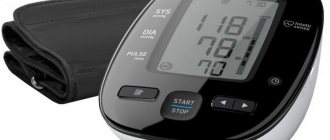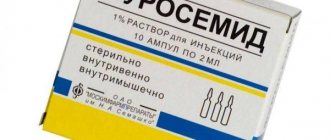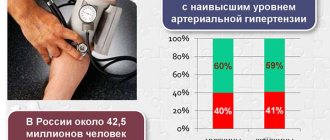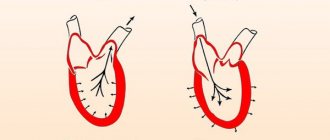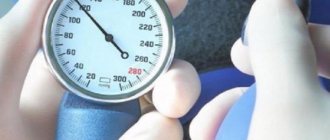High blood pressure is far from uncommon even for young people; they are increasingly faced with the unpleasant symptoms of hypertension. Therefore, everyone should know what to do to cope with this problem, how to prevent subsequent pressure surges.
The first thing that is important to remember: if your blood pressure has increased, you should not hope that the condition will improve on its own; you must immediately contact a doctor for examination and receive recommendations for treatment.
Since hypertension is a chronic disease, it requires constant attention to oneself. When high blood pressure has become a constant companion of the patient, he needs to follow the prescribed treatment for life. If the tonometer shows high numbers only from time to time, the patient should take preventive measures.
High blood pressure includes:
- change in lifestyle;
- changing food and bad habits;
- moderate physical activity;
- minimizing nervous feelings.
Otherwise, one day your blood pressure will rise sharply, causing severe health problems. Such conditions are called hypertensive crisis.
Causes of pressure 200 to 100
For each person, depending on age and the presence of chronic pathologies, blood pressure varies from the norm to 120/80. Therefore, an attack of malaise can occur even with a slight excess. But when blood pressure rises to 240 or even higher, this threatens complications. Internal organs such as kidneys, heart, and brain are affected. Such an attack can lead to consequences in the form of poor vision or its complete loss. The reasons for this pressure may be:
- constant worries, stress;
- genetic disposition;
- environment;
- high fat content in the diet (butter, sour cream, sausage, cheese, cakes);
- a large amount of alcohol consumed, which directly affects the heart rate (changes towards an increase);
- high salt content in food, which leads to fragility of blood vessels;
- sedentary work, sedentary lifestyle;
- smoking;
- overweight;
- complication after illness.
Enter your pressure
Move the sliders
Norm or pathology
In some cases, a slight deviation of indicators from the norm by 5-10 units, both up and down, is acceptable. But blood pressure 240 over 120 (240 over 130, as well as blood pressure 240 over 140) cannot be called a minor deviation. This is a serious pathology called hypertensive crisis.
It is worth paying attention not only to increased systolic and diastolic indicators, but also to the difference between them. With normal blood pressure, this difference should be 40 units. In this case, the “run” is more than 100 units. Such a difference is dangerous not only for the heart, but also for the entire body as a whole.
High blood pressure is stress for the whole body, because it works in an enhanced mode
The disease requires immediate intervention by a specialist and an urgent reduction in blood pressure. The reasons for this phenomenon can be stress, heart and vascular diseases, diabetes, obesity, etc. The greatest risk factor is the elderly, but it is possible that a hypertensive crisis can occur at a young age.
Note. The normal blood pressure for a healthy adult is 120 over 80, and the pulse is 60-80 beats per minute. If, with minor deviations, any symptoms begin to bother you, you should consult a doctor as soon as possible.
Hypertensive crisis
A sharp increase in blood pressure of 240 to 120 is the main symptom of a hypertensive crisis. Today there are three main forms that require immediate medical intervention:
- Hypertensive cardiac crisis. It is characterized by an increase in blood pressure to 160 to 100. The main symptoms include shortness of breath, chest pain, rapid heartbeat, and dry cough. The consequences of this type of crisis are myocardial infarction.
- Hypertensive angiohypotonic crisis is a consequence of increased blood microcirculation in the vessels of the brain. This form is the most common. It is characterized by tonometer readings ranging from 170 to 110 and above. Characterized by lethargy, vomiting, dizziness. Often there is a feeling of fear for your life. Severe headaches of a pressing nature are often observed.
With hypertensive ischemic crisis, numbness of the facial muscles and dizziness occur
- Hypertensive ischemic crisis. The phenomenon is quite rare, however, it does occur. It must be said right away that an increase in pressure to 240 to 100 and higher to a pressure mark of 240 to 160 are the main signs of a hypertensive crisis of this form. Among the obvious symptoms, one can also note loss of speech and vision for a short time, numbness of the limbs or facial muscles, dizziness, and loss of coordination of movements. What to do if the pressure rises to 240 over 120? Every effort must be made to reduce these values. An increase in blood pressure to 240 to 120 or higher has negative consequences that can lead to a cerebral stroke. Therefore, it is important to take timely measures to reduce it.
Symptoms with a pressure of 200 over 100
If high blood pressure persists for long periods of time and very rarely returns to normal on its own, then due to its changes, the speed of blood flow increases and the walls of blood vessels become thicker, and because of this, the lumen in them decreases. During this period, the sick person has the following symptoms:
- pain in the back of the head, a feeling of pulsation, especially in the temporal part;
- blurred vision, pathological changes in the fundus, dilated blood vessels;
- constant fatigue, even in the morning;
- noise in ears;
- rapid heart rate, aching pain in the heart area;
- swelling of the eyelids, face, hands;
- redness of the facial skin, appearance of vascular networks;
- memory impairment;
- numbness of the limbs, sweating;
- involuntary urination, urine analysis reveals albumin proteins;
- sudden changes in pressure - hypertensive crisis.
Advanced hypertension negatively affects all human organs, namely:
- Brain. With hypertension, the lumen in the blood vessels narrows, which leads to oxygen starvation of this most important organ, and as a result, a stroke may ultimately occur.
- The cardiovascular system. High blood pressure provokes severe stress on the vessels, they wear out more quickly and fatty plaques are deposited on their walls. With changes in the healthy functioning of blood vessels, the nutrition of the heart muscle stops, and this entails angina pectoris. If left untreated or improperly treated, high blood pressure will lead to a heart attack.
- Urinary system. With changes in its operation, the filtering function deteriorates. A large amount of protein and other substances entering the circulatory system are detected in the urine. If treatment is ignored in older people, this leads to kidney disease.
- Organs of vision. High pressure negatively affects the microvessels located in the human eyeball. Due to frequent changes in pressure, irreversible changes in the retina occur.
Often there are no signs of increased blood pressure of the hypertensive type, which is why developing hypertension is also called the “silent killer”. It’s just that one day a person suffers a heart attack or stroke due to another surge in pressure, even an insignificant one against the background of the general excess. Interruptions in heart rate, nausea, causeless anxiety, heart pain, darkness before the eyes followed by loss of consciousness, migraine, loss of coordination - all these are symptoms of hypertension.
You cannot ignore the symptoms of high blood pressure; they will help prevent the dangerous consequences of hypertension in time.
How do ALT and AST levels change in hepatitis C?
How do ALT and AST levels change with hepatitis C? This type of hepatitis is an infectious form. In this case, it is the liver that suffers quite a lot. You can become infected with it through blood transfusions, drug injections, or sexual contact with a patient. Alanic acid promotes stable functioning of the body. In this case, transaminase levels are very important (ALT - alanine aminotransferase, AST - aspartate aminotransferase). They will help identify the presence of the virus, then prescribe therapy and, if necessary, adjust it.
Changes in AST and ALT in hepatitis
Liver enzymes reach high values several times during the development of hepatitis C:
- The first time this happens is 14 days after the virus enters the body, due to the fact that the first characteristic signs appear. This provokes the release of enzymes into the blood. Then the indicators return to normal.
- The second time this happens is at the first clinical manifestations of the disease. The patient experiences weakness, loss of appetite, and gets tired quickly. Such phenomena will be observed several months after the first incident.
- An increase in concentration from 6 to 10 times may mean that the disease is in the development stage and is of moderate severity. In this case, changes in AST and ALT indicators will occur in waves. This provokes the release of the virus into the blood and promotes infection of healthy cells.
As hepatitis C develops, yellowing of the skin may appear.
In this case, the amount of bilirubin increases. But your skin tone may not change. This case is considered a pathology, and changes in AST and ALT levels can only be determined by biochemistry analysis. It will help identify the presence and level of aspartic acid. If the situation improves, a period of remission begins. At this point, the amount of enzymes will be normalized. But this does not mean complete recovery and victory over the virus.
When AST and ALT values fluctuate, it is quite difficult to identify their deviations from the norm. A blood chemistry test may also be biased. Therefore, characteristic external symptoms will play a big role here.
An example is this. If ALT is 127 U and AST is 160 U, the patient will have liver damage. At the same time, other diseases may not be considered. At the same time, the degree of changes is secondary and means the formation of a tumor or cirrhosis.
Treatment
The correct therapeutic course can only be prescribed by a specialist after a complete diagnosis. As a rule, therapeutic measures are aimed at treating the underlying disease that causes arterial hypertension.
Only a doctor can prescribe a course of treatment, because every body is individual.
Also prescribed are medications that lower blood pressure, improve the functioning of the cardiovascular system, and relieve symptoms. Most often used:
- Beta-blockers - Atenolol, Vasocardin, Anaprilin;
- Calcium antagonists - Amlodipine, Nifedipine, Verapamil;
- ACE inhibitors - Captoril, Enalapril, Capoten;
- Diuretics - Furosemide, Indapamide, Hypothiazide.
In addition to these drugs, sedatives are often prescribed, as well as medications to eliminate symptoms. In case of vomiting - antiemetic, if there is a headache - antispasmodics, and other drugs depending on the patient's condition.
What to do with high blood pressure 240?
If the pressure rises to 240 to 140, before starting to take many medications, the patient needs to calm down and pull himself together. Fear is one of the manifestations of hypertension. Medicinal tinctures of valerian and motherwort and Corvalol will help overcome anxiety. Be sure to call an ambulance and take the following measures before paramedics arrive:
- Provide fresh air. To do this, you need to open all windows.
- A few deep breaths. This will help restore breathing, enrich the lungs, and therefore the blood, with oxygen.
- Take a reclining position.
- Measure blood pressure every 10–15 minutes.
If an attack occurs, it is necessary to call an ambulance as quickly as possible and give the victim medicine for high blood pressure. Most often, the drug Capoten is used for these purposes. In the first hour, you can reduce the pressure by no more than 20-25% of the existing values.
Capoten quickly reduces blood pressure and improves well-being
To do this, you need to place one tablet of the drug under your tongue. If the dosage of the medicine is 25 mg, then you can take 2 tablets at once. It is also possible to use Nifedipine. Dosage - 1 tablet under the tongue. If the pressure does not decrease, then you can take another tablet 15-20 minutes after the first. Also, to improve the patient’s condition, it is necessary:
- Place him in bed on a high pillow.
- Ventilate the room (fresh air normalizes breathing).
- It is important not to let the victim panic.
- Apply mustard plasters to the feet, calf muscles and the back of the head (for no more than 15 minutes).
- For headaches, give the patient a No-Shpa tablet or another antispasmodic.
- If your heart hurts, then a Nitroglycerin tablet (under the tongue) will help.
Cold hand baths, breathing exercises, and hot foot baths help reduce blood pressure. Cold compresses can be applied to the forehead and sides.
Have you been struggling with HYPERTENSION for many years without success?
Head of the Institute: “You will be amazed at how easy it is to cure hypertension by taking it every day.
High blood pressure is far from uncommon even for young people; they are increasingly faced with the unpleasant symptoms of hypertension. Therefore, everyone should know what to do to cope with this problem, how to prevent subsequent pressure surges.
The first thing that is important to remember: if your blood pressure has increased, you should not hope that the condition will improve on its own; you must immediately contact a doctor for examination and receive recommendations for treatment.
Our readers successfully use ReCardio to treat hypertension. Seeing how popular this product is, we decided to bring it to your attention. Read more here...
Since hypertension is a chronic disease, it requires constant attention to oneself. When high blood pressure has become a constant companion of the patient, he needs to follow the prescribed treatment for life. If the tonometer shows high numbers only from time to time, the patient should take preventive measures.
High blood pressure includes:
- change in lifestyle;
- changing food and bad habits;
- moderate physical activity;
- minimizing nervous feelings.
Otherwise, one day your blood pressure will rise sharply, causing severe health problems. Such conditions are called hypertensive crisis.
The doctor is talking about a hypertensive crisis if the blood pressure has reached 250 to 120 or even 250 to 150 millimeters of mercury. However, it should be understood that these numbers may be individual for each patient.
There are many reasons for the development of this condition, the main one being the presence of arterial hypertension. Often, sudden surges in blood pressure to high levels occur when you stop taking antihypertensive drugs; doctors call this phenomenon withdrawal syndrome.
In addition, blood pressure increases for the following reasons:
- excessive physical activity;
- hypokalemia;
- stress;
- cerebral ischemia;
- excessive sensitivity to changing weather conditions;
- addiction to alcoholic drinks.
If a woman suffers from hypertension, her blood pressure may rise to 120 or higher during menopause.
Approximately the same symptoms occur with exacerbation of coronary artery disease, circulatory disorders in the brain, and acute heart failure.
There are two types of hypertensive crisis: complicated, uncomplicated. In the first case, the risk of damage to internal organs, stroke, and heart attack increases. In this condition, it is important to know what to do to provide the patient with quick emergency care.
During an attack of hypertension, many symptoms are observed, but the main sign of the pathological condition is a sharp increase in pressure up to 250-260/120-150 mm Hg. Art. Among other signs it is necessary to highlight:
- cold sweat;
- goose bumps;
- anxiety, restlessness;
- increased heart rate;
- lack of air;
- tremor of the upper extremities;
- nervous overexcitement.
At the very beginning, the patient will experience severe pain in the head, which is accompanied by nausea, vomiting, fear of light, tinnitus, and dizziness. Head pain may worsen if a person sneezes sharply.
Hypertensive crisis develops in different ways. Some patients become overly irritable, whiny, they develop a feeling of fear, and red spots appear on the skin of the chest.
It happens that the functioning of the digestive tract is disrupted, diarrhea and frequent urge to urinate appear. The patient's systolic pressure will increase, reaching extremely high levels - from 230 and above. This provokes:
- increased heart rate;
- increase in pulse and venous pressure.
An uncomplicated attack can last several days, but it has less acute symptoms. The patient's consciousness is confused, a feeling of drowsiness, stupor appears, and a headache.
What to do if blood pressure rises above 250/120? Treatment must be carried out in several stages; during an attack, prompt assistance should be provided, even before the medical team arrives. After this, doctors will decide what to do - hospitalize the patient or leave him for home treatment.
First, you need to position the patient so that he is in a semi-sitting position. If the patient is lying in bed at this time, a couple of pillows are placed under his head to ensure free breathing and prevent suffocation, which often happens during a hypertensive crisis.
When a patient previously consulted a doctor to prescribe medications against hypertension, he needs to take the medications that were recommended by the doctor. To reduce blood pressure quickly and effectively:
- the tablets are placed under the tongue;
- slowly dissolve.
Additionally, it is important to take blood pressure measurements as often as possible and monitor the indicators; they must decrease smoothly. After just 30 minutes, the pressure drops by 30 units, after 1 hour – by 50. If the optimal pressure level is reached, there is no need to take any other measures.
The pressure should not be reduced too sharply, as this will cause circulatory problems in the brain.
During a hypertensive attack, it is important to do everything so that the patient quickly gets rid of feelings of fear and anxiety. To normalize overexcitation and psycho-emotional state, it is recommended to take a sedative. Other medications are taken only after the ambulance team arrives, after the doctors have selected the right medicine.
Traditional methods
In addition to medications, it is recommended to practice traditional methods of normalizing blood pressure. They are especially good for emotional stress, when the patient needs to calm down.
Each herb is crushed, take a tablespoon of the mixture, pour 250 ml of boiling water and leave for 30 minutes. After this, the product is filtered and consumed half a glass before meals three times a day.
To lower blood pressure to 120 and below, use a tincture of other herbs: hawthorn, horsetail, cucumber, motherwort, birch leaves, adonis. It is prepared in the same way as the previous remedy, take half a glass 3 times a day, always before meals.
Beetroot juice, which you drink 100 ml three times a day after meals, helps with high blood pressure. The duration of such treatment will be 3 weeks. To increase efficiency, natural honey and lemon are added to the juice in a ratio of 1 to 2. Treatment is taken in half a glass 2 times a day, preferably 1 hour after meals.
Hawthorn juice has medicinal properties and is consumed 30 minutes before meals. To dilate blood vessels, take cranberry juice, grind a glass of berries with sugar or honey, eat a tablespoon 3 times a day before meals.
The menu should also include seafood, dairy foods and lean meat. Watermelon helps get rid of excess moisture in the body, and as a result, blood pressure decreases.
After suffering a hypertensive crisis, when the pressure is approximately 120/80, the patient must completely give up smoking, alcoholic beverages, and foods that greatly increase blood pressure. In order to promptly identify changes in your blood pressure, you need to purchase a tonometer, systematically measure your blood pressure, and monitor your lower and upper pressure readings. And the video in this article will answer the important question about deciphering the numbers of your upper blood pressure.
Low blood pressure is considered to be pressure below 100/60 mm Hg. Art.
The main symptoms of low blood pressure are drowsiness, weakness, and dizziness. To increase it, you can drink a cup of strong tea or coffee. If the described complaints persist for several days against the background of low blood pressure, that is, excluding other possible causes for the appearance of the above symptoms, such as changes in weather, colds, overwork, it is necessary to consider the issue of adjusting therapy.
Important! If the patient has previously been prescribed medications for arterial hypertension, then they must be taken strictly according to the doctor’s prescription. Often, exceeding dosages leads to a sharp decrease in blood pressure to critical levels and to the development of dangerous pathologies.
Consequences of pressure 240 to 120 mm Hg. st
When a hypertensive crisis occurs, it is necessary to take all measures to lower blood pressure without delay. Indicators of 240 to 120 are very dangerous for human life.
With such indicators, the heart and blood vessels begin to work harder, which often leads to irreversible consequences. If you do not consult a doctor in time and start treatment, there is a risk of dangerous pathologies. Such as:
- Serious disturbances in the functioning of the central nervous system;
- Pulmonary edema;
- Angina;
- Clouding of consciousness;
- Convulsions and paralysis (complete or partial);
- Myocardial infarction;
- Stroke;
- Impaired kidney function;
- Development of pathologies in the endocrine system.
Such pressure is dangerous for any age category. Pregnant women are no exception. Blood pressure of 240 over 120 is dangerous not only for the expectant mother, but also for the baby inside the womb. Often, due to a hypertensive crisis, premature birth (miscarriage) begins.
If high blood pressure is not treated, life expectancy may be reduced by 10-15 years.
Symptoms of the disease
It must be said that hypertension has recently been gaining momentum, especially among the younger generation. High blood pressure has a number of characteristic symptoms:
- headaches of varying intensity;
- dizziness;
- darkening or cloudiness in the eyes;
- pain in the heart area;
- increased heart rate;
- heart rhythm disturbances;
- nausea;
- nervous fatigue;
- weakness.
If a person experiences these symptoms, they should immediately measure their blood pressure. This is done using a tonometer. It is important to remember the rules for measuring pressure. Otherwise, the tonometer may show an incorrect result.
When blood pressure increases, it is important to notice these changes in time. Timely measures taken to normalize it can prevent serious health consequences. This is done in order not to aggravate the situation and not end up in the hospital, as emergency medical care will be required.
Features of specific pressure values
| Blood pressure value (mm Hg) | Peculiarities |
| 220 by 120 | Dangerous pressure, which is most often associated with serious disorders of the cardiovascular system. With such indicators, tachycardia, arrhythmia, and heart pain are most often associated. If you do not call an ambulance in time, there is a risk of stroke, heart attack, hemorrhage and other pathologies. |
| 230 by 120 | A hypertensive crisis with such indicators is almost always accompanied by a rapid heartbeat and increased pulse pressure. The condition is life-threatening. In this case, immediate first aid to the victim and medical intervention are required. |
| 240 by 120 | This form of hypertensive crisis usually develops due to high-risk arterial hypertension. If you do not call an ambulance in time and do not begin to lower blood pressure in a timely manner, then most often such pressure will leave consequences - disturbances in the functioning of the kidneys, adrenal glands, heart, brain cells and other target organs. |
| 250 by 120 | A pressure of 250 over 120 is defined as a hypertensive crisis and most often occurs due to self-cessation of prescribed medications for hypertension. With a systolic reading of 250 units, the heart muscle is overstrained, and the vessels are constantly working “to the point of strain.” In almost all cases, after stopping the attack, some consequences remain. But the sooner you call an ambulance, the greater the chances of avoiding dangerous pathologies. |
| 260 by 120 | If you do not start lowering your blood pressure readings, then often during a hypertensive crisis with an upper pressure reading of 260 mm Hg. st recorded death. This form of attack is extremely dangerous for human health, as some of the brain cells die. In addition, if blood pressure is not lowered urgently, in most cases vascular rupture occurs. |
Any of these values is dangerous for human life, so immediate emergency assistance and calling a doctor are required. For some indicators, the consequences remain regardless. However, with timely assistance, the condition of the victim can be significantly improved and his life saved.
There is no point in trying to eliminate a hypertensive crisis using traditional medicine. In this case it is a waste of time. Treatment can only be medication. You can turn to folk remedies only after the attack has stopped. This would be a good complementary therapy.
Any of these values is dangerous for human life, so immediate emergency assistance and calling a doctor are required. For some indicators, the consequences remain regardless. However, with timely assistance, the condition of the victim can be significantly improved and his life saved.
HYPERTENSIVE CRISIS
This disease occurs as a result of a rapid, severe disruption of the regulatory mechanisms of blood pressure.
The disorder occurs against the background of hypertension. As a result, blood pressure increases greatly, blood circulation in the internal organs is disrupted. With this disease, an ambulance is often called. In the West, cases of this disease have dropped to 1% (from 7%). This is due to improved methods of treating crises and effective diagnosis of diseases. In Russia the situation is unsatisfactory. 40-60% of people know about the disease. The prevalence of the disease is about 40%. Only 20-45% of people use medication treatment services. This causes a general increase in the number of hypertensive crises. For example, in the city of Moscow in the period 1997-2002, there was an increase in crises by 9%. Also the reason for this increase is the lack of coordinated work of ambulances, therapeutic hospitals, and clinics. Hypertensive crises are divided into two types:
- Complicated – damage to target organs. This is an emergency condition. Often leads to death. Requires emergency care and hospitalization.
2. Uncomplicated – high blood pressure, target organs are relatively intact. Help should be provided no later than several hours after the crisis. Hospitalization is not necessary.
Hypertensive crisis. Symptoms
The blood supply to the heart and brain of the head is disrupted. Blood pressure rises to 260 over 120. The person gets tired easily and has insomnia. The head begins to ache in the back of the head. In addition, shortness of breath and chest pain, various neurological disorders appear. The disease is especially dangerous for people who already have brain and heart disease.
Hypertensive crisis. How to treat.
To lower blood pressure, you need to use a special blood pressure device. In order to stop a hypertensive crisis, you need to use Corinfar or Kapoten. If the pressure exceeds 200, you need to apply clonidine sublingually. If the crisis cannot be stopped, one of the following drugs must be injected into a vein: enalapril maleate, magnesium sulfate, clonidine. If the crisis occurs with attacks of angina, you need to slowly inject nitroglycerin into a vein, which is diluted in 200 ml of 0.9% NaCl (sodium chloride) solution, or 5% glucose solution. In special cases, pentamin is administered. Depending on other diseases, this therapy may vary. In any case, urgent help is needed.
